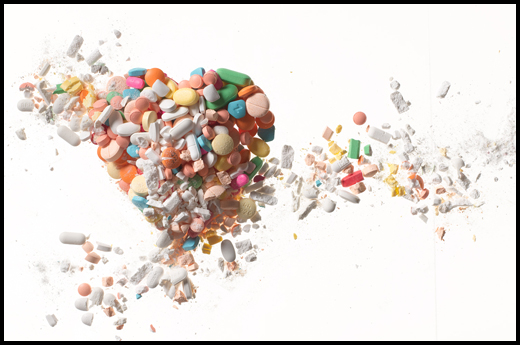by guest blogger Deirdre Imus, author and environmental health advocate
Not long after the unfathomable events of December 14, 2012, unfolded at Sandy Hook Elementary School in Newtown, Connecticut, we all began searching for answers. What could possibly motivate someone to act in such a murderous fashion and kill more than two dozen people, most of them children? Was this individual mentally disturbed? Did he have a personality disorder? Social anxiety? What—if any—treatment was he receiving from medical professionals? Was he taking any medications? How can we prevent this from ever happening again?
These queries may haunt us—and the victims’ loved ones—forever. Nobody will ever know for sure why this young man committed this horrific act, but we can look for clues in his behavior and that of the gunmen who came before him.
In a recent article on the Natural News website, the psychiatrist Dr. Peter Breggin highlighted a 2010 scientific review in the journal PLOS ONE looking at violence associated with prescription drug use. Pulling data from the Food and Drug Administration’s Adverse Event Reporting System, researchers identified 1,527 cases of violence disproportionately reported for 31 drugs from 2004 through September 2009.
For the purposes of the study, “serious adverse events” were defined as homicide, homicidal ideation, physical assault, physical abuse, or violence-related symptoms; in other words, characteristics in keeping with the violent behavior on display at Sandy Hook Elementary School, a movie theatre in Colorado, a shopping mall in Oregon, and elsewhere.
So which drugs were specifically implicated as causing people to tend toward violence? The primary suspects are 11 antidepressants; six sedative/hypnotics; three drugs for attention-deficit/hyperactivity disorder (ADHD); and a drug called Varenicline that aids in smoking cessation.
In other words, 20 of the 21 drugs that were most likely to cause people to engage in “serious adverse events” are the very drugs designed to cheer a person up, stabilize his or her mood, and subdue agitated behavior. Why this seemingly opposite effect is taking place in select individuals is a concern that seems worthy of further exploration—especially considering that at least 12 million young people in this country are on psychiatric medication, according to a 2011 article by psychologist John Breeding, PhD.
Even if someone taking antidepressants, sedatives, or drugs for ADHD doesn’t exhibit violent behavior, there are other potentially serious side effects that come with taking these medications. People may experience nausea, diarrhea, headaches, sexual problems, trouble sleeping, and nervous feeling—and that’s just with antidepressants.
People tend to ignore the list of possible side effects that comes with every medication—prescription or otherwise—but as with anything, it’s important to consider exactly what you are ingesting and how it might affect you or your loved ones. Not only will you know what strange sensations to look for in yourself, but you’ll be more aware of the signs of odd behavior or health problems in family members, too.
Obviously, not every person who takes a prescription drug to treat depression, social anxiety, or ADHD will exhibit violent behavior. It’s unclear whether the young man who did so at Sandy Hook Elementary was taking any such medications, but reports have indicated that the shooter in Colorado was in treatment with a psychiatrist, and one of the Columbine shooters was taking an antidepressant.
On average, someone in this country dies every 19 minutes from an unintentional prescription drug overdose, according to the U.S. Centers for Disease Control and Prevention. Starting these medications can cause extreme reactions, such as irritability and agitation, and going off them may be even worse: In an article on his website, the psychiatrist Dr. Breggin notes that withdrawal reactions can last days and sometimes longer, “causing some patients to feel depressed, suicidal, or even violent.”
Perhaps it’s time to weigh the benefits versus the risks of prescribing these drugs, and to seek out alternatives like cognitive behavioral therapy, nutritional supplements that have proven effective in clinical trials, light therapy, exercise, or meditation.
 Deirdre Imus, founder of the site devoted to environmental health, dienviro.org, is president and founder of The Deirdre Imus Environmental Health Center at Hackensack University Medical Center and cofounder/co-director of the Imus Cattle Ranch for Kids with Cancer. She is a New York Times best-selling author and a frequent contributor to FoxNewsHealth.com and Fox Business Channel.
Deirdre Imus, founder of the site devoted to environmental health, dienviro.org, is president and founder of The Deirdre Imus Environmental Health Center at Hackensack University Medical Center and cofounder/co-director of the Imus Cattle Ranch for Kids with Cancer. She is a New York Times best-selling author and a frequent contributor to FoxNewsHealth.com and Fox Business Channel.





I think it’s important to be mindful of the effects related to taking medications, but I also think it’s potentially dangerous to start down the road toward demonizing medications with regard to these tragic deaths. I am very thankful that I can wake up every day and take my medication – it, along with family support, therapy and mindfulness practice, may very well have saved my life.
That said, the trend in the USA toward trusting medication to solve a problem (and not just psychological problems) without taking other related steps (e.g. exercise, therapy, changing the basic circumstances around the problem) is alarming. In the end, a quick fix is neither quick nor a fix. I don’t know how to start changing a culture awash in media and advertising that urges us to accept faster, better, now as normal so that we continue to support a sick system, but something needs to happen.
Another issue embedded in this problem is the availability and acceptance of the use of firearms. Regardless of medication use and abuse, in these tragedies it was the gun that killed the people. Focusing on medication ignores this crucial issue.
You mean it isn’t the guns, Deirdre?? Who woulda thunk??!!
::rolling my eyes::
Thank you-thank you- thank you… for pointing out the “seemingly-to-me-but-not-to-nearly-enough-folks” obvious… in not only this but *many* things!
–Andrea
XOXO
Thank you for saying this, no mention of this in the media anywhere. But we are a drug culture, a pill for every little ill that befalls us. And side effects don’t seem to matter to people, they think because a doctor prescribes it it’s ok. Maybe we need a common sense pill! We seem to have lost that somewhere down the line.
Once you get the oil from your car towards your driveway. Secured folding door hinges: Mostly, many manufacturers
are making various sized patio door. Fire Patio Door are vital to all homes, offices and public areas, they help to prevent
the leakage of water.
kami menyediakan Timbangan Digital murah tapi berkualitas hadir untuk anda. produsen timbangan electronic digital merk kenko, digi. harga timbangan digital murah john dengan timbangan a digital harga yang sangat murah sekali.
Once correct bulbs are chosen and installed, the chandelier should give off sufficient light coverage without blinding anyone.. You can narrow your choice by considering only the ones that will complement to the look of your room as well as to the other items you have inside.. And since you are renting a crystal chandelier, it is important that you have to make sure that it can be delivered to your home safely..